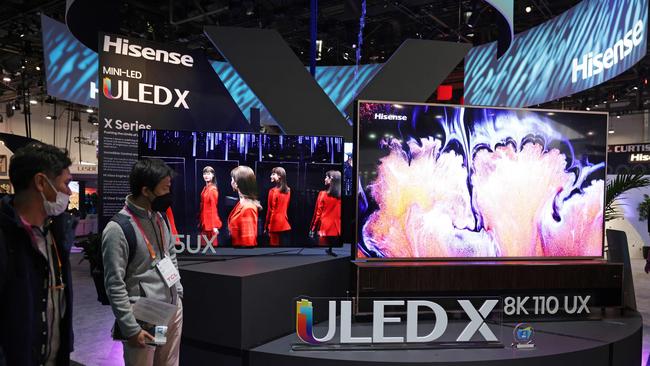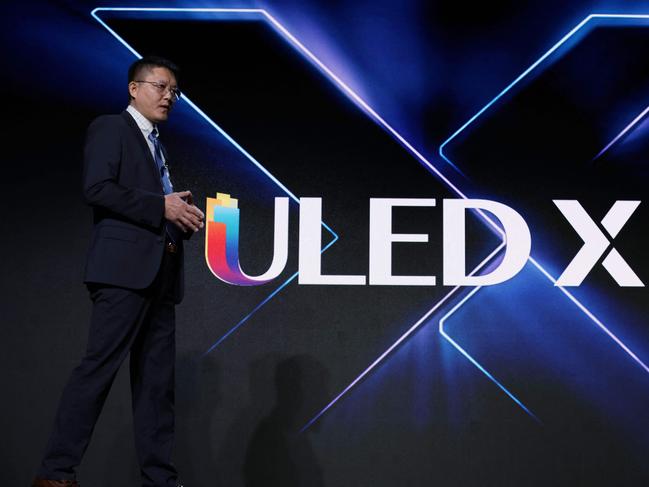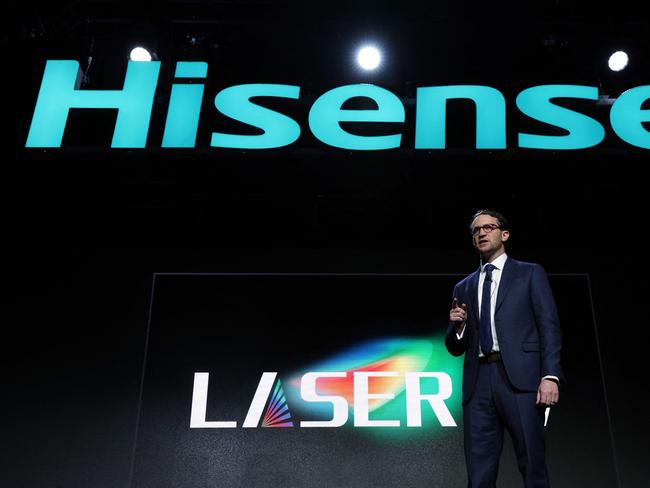Inflation is an advantage to us: Hisense
The Chinese electronics giant says its premium yet value-for-money TV range will continue to eat into Samsung and LG’s Australian market share.

Inflationary and interest rate pressures are no worry to Chinese electronics giant Hisense, which is predicting a bumper 2023 with Australian consumers set to buy more televisions than they did last year, and turning increasingly to value-based options when making their purchasing decisions.
New research from Statistica shows Australians are expected to spend $US1.78bn ($2.59bn) on televisions in 2023, up slightly from $US1.75bn in 2022, but down from $US1.88bn in 2021 when much of the nation was kept at home in rolling lockdowns amid the Covid pandemic.

Gideon Lui, Hisense’s head of marketing for Australia and New Zealand, said in an interview at the world’s largest consumer electronics show CES that in challenging economic times consumers tend to steer towards brands that offer more value for money, and sales numbers are already reflecting that trend.
He said the company’s high-end ULED TV range has grown 30 per cent over the past three years.
“Were continuing to see growth, and we’re actually quite excited, because we almost see (inflation) as an advantage to us, being a challenger brand,” Mr Lui said. “One of our core pillars is premium attainability, and we understand that people may be doing a bit tighter budgeting next year but they still want the best quality.
“What we are giving them is more for less, and for us that is definitely a key thing. And the way to fight inflationary concerns is to innovate, and to give people a reason to continue choosing Hisense. We are very excited for the coming years and how the market will continue to shift.”
Sales estimates show Hisense is Australia’s third most popular TV manufacturer, behind Samsung and LG, but the company is hoping that significant upgrades to its line-up will help it continue to win market share. The company is the second most popular TV maker globally, and claims the number one position in China.
“Looking at the Australian market next year obviously there’s going to be rising inflation and interest rates and things like that, and I think we’re actually in a really good position,” Hisense Australia regional training manager Christopher Mayer said.
“Hisense is a premium global brand, that’s what we see ourselves as, and it’s been a meteoric rise for us in Australia.”

On the ground in Las Vegas last week Hisense unveiled what it describes as the best LED TV available on the market from any manufacturer. Its flagship model is an 85-inch television dubbed the ULED X, which uses Mini-LED technology and boasts an expanded viewing angle, an “ultra low reflection panel” and compatibility with technologies such as Dolby Vision, Wi-Fi 6E, NextGen TV and FreeSync Premium Pro. The TV is also brighter than its rivals, offering more than 2,500 nits of brightness, compared to LG‘s G3 for example which offers 2,000 nits.
The company says the ULED X, which has 20,000 Mini-LEDs with over 5,000 dimming zones, can achieve three times the environmental contrast of OLED TVs, two times the dynamic range of OLED TVs, and is ideal for Australian homes given how bright and sunny living rooms can be. The TV also features a newly designed seven-speaker system that delivers more than 80 watts of power and Dolby Atmos spatial sound.
Local pricing and a release date are yet to be revealed.
Hisense also announced upgrades its U8, U7 and U6 series models, adding Mini-LED technology to those TVs and a range of new gaming and audio features. It launched six new products within its Laser TV and Laser Cinema line-up, as Australians increasingly look to purchase screens 100-inches and larger.
It’s also expanding its ConnectLife smart home app from its air conditioners to its entire line-up of 2023 home appliances, amid statistics showing more than two thirds of Australian households had at least one smart home device in 2022, up 20 per cent year-on-year.
The ConnectLife app includes features like ‘Holiday Mode’, which can save energy by placing the refrigerator in standby mode once perishables have been removed, and ‘Super Cool’ mode which can quickly drop the refrigerator temperature to cool drinks before a party, for example.
“A lot of Australians when they think of Hisense, their first thought is still Hisense arena,” Mr Lui said.
“We’ve got the name into people’s minds. And now what we want to do is come back to the focus of the value offering, to show people who we are and what we stand for as a brand, that we provide value to their lifestyles, not just in their living room now but in all different rooms across our portfolio.”
David Swan travelled to Las Vegas as a guest of Hisense.


